Exploring the Influence of Social Media Usage for Academic Purposes Using a Partial Least Squares Approach
Abstract
:1. Introduction
2. Literature Review
3. Data and Methods
3.1. Data
3.2. Research Methodology
3.3. Partial Least Squares Method (PLS)
| Algorithm 1 Partial least-squares (PLS) algorithm [36,37]. |
| Input: standardize latent variable Output: latent constructs score, loading and path coefficients, location parameters Step 1: Estimation of latent variable scores Iteratively (1.1–1.4) until convergence is achieved or the maximum number of iterations is reached. Then go to Step 2. 1.1 outer approximation of the latent variable scores, 1.2 estimation of the inner weights, 1.3 inner approximation of the latent variable scores, and 1.4 estimation of the outer weights. Step 2: Estimation of outer weights/loading and path coefficients. Step 3: Estimation of location parameters. |
4. Results and Discussion
4.1. Measurement Model
4.2. Model Reliability
4.3. Convergent Validity
- (a)
- Achieve a score greater than or equal to 0.7 for the outer loadings.
- (b)
- Ensure that the score of average variance extracted (AVE) for all latent variables is more than 0.50 [42]. A score of 0.4 is adequate [43] with the condition that the composite reliability score is more than 0.6 [44]. Table 4 shows that the convergent validity is acceptable based on the obtained variance extracted score ranging from 0.492 to 0.739. Discriminant validity should evidence that the construct (latent variable) in the PLS path model has the most robust relationship score as compared with other construct variables. Table 5 shows that the obtained results of the square root of AVE and constructs correlation score were in the accepted ranges, which indicates a satisfactory discriminant validity for constructs.
4.4. Structural Model Analysis
5. Conclusions
- (a)
- Encourage students to use social media for academic purposes and practice;
- (b)
- Encourage teachers to create and monitor special classes for engaging students in discussions and presentations;
- (c)
- Create free space for dialogue between students and exchanging views regarding solving school assignments;
- (d)
- Closely monitor and direct the students to use social media positively as flipped classrooms;
- (e)
- Restrict the students from wasting their time indulging in unproductive chat purposes;
- (f)
- Raise awareness of the risks involved in using social media platforms (due to security concerns) rather than curtailing them.
Author Contributions
Funding
Conflicts of Interest
References
- Statista. Comparison of Global and Middle Eastern Internet Penetration Rate. 2019. Available online: https://0-www-statista-com.brum.beds.ac.uk/statistics/265171/comparison-of-global-and-middle-eastern-internet-penetration-rate/ (accessed on 25 January 2021).
- Emmert-Streib, F.; Dehmer, M. Data-driven computational social network science: Predictive and inferential models for Web-enabled scientific discoveries. Front. Big Data 2021, 4, 591749. [Google Scholar] [CrossRef]
- Emmert-Streib, F.; Yli-Harja, O.P.; Dehmer, M. Data analytics applications for streaming data from social media: What to predict? Front. Big Data 2018, 1, 2. [Google Scholar] [CrossRef] [PubMed] [Green Version]
- Statista. Number of Worldwide Social Network Users. 2019. Available online: https://0-www-statista-com.brum.beds.ac.uk/statistics/278414/number-of-worldwide-social-network-users/ (accessed on 25 January 2021).
- DIGITAL. Social Media statistics for Oman. 2021. Available online: https://datareportal.com/reports/digital-2021-oman (accessed on 29 May 2021).
- Uddin, M.S.; Al Mamun, A.; Iqbal, M.A.; Nasrullah, M.; Asaduzzaman, M.; Sarwar, M.S.; Amran, M.S. Internet addiction disorder and its pathogenicity to psychological distress and depression among university students: A cross-sectional pilot study in Bangladesh. Psychology 2016, 7, 1126. [Google Scholar] [CrossRef] [Green Version]
- Al-Rahmi, W.; Othman, M. The impact of social media use on academic performance among university students: A pilot study. J. Inf. Syst. Res. Innov. 2013, 4, 1–10. [Google Scholar]
- El Khatib, D.; Khan, F.R. Implications of social media networks technology in interpersonal skills and academic performances. Int. J. Manag. Innov. Entrep. Res. EISSN 2017, 3, 99–110. [Google Scholar] [CrossRef] [Green Version]
- Nasrullah, S.; Khan, F.R. Examining the Impact of Social Media on the Academic Performances of Saudi Students-Case Study: Prince Sattam Bin Abdul Aziz Univ. Humanit. Soc. Sci. Rev. 2019, 7, 851–861. [Google Scholar] [CrossRef]
- Chytas, D. Use of social media in anatomy education: A narrative review of the literature. Ann. Anat. Anat. Anz. 2019, 221, 165–172. [Google Scholar] [CrossRef]
- Hashim, K.F.; Rashid, A.A.S. Social Media for Teaching and Learning within Higher Education Institution: A Bibliometric Analysis of the Literature (2008–2018). Int. J. Interact. Mob. Technol. 2018, 12, 4–19. [Google Scholar] [CrossRef]
- Al-Rahmi, W.M.; Alias, N.; Othman, M.S.; Marin, V.I.; Tur, G. A model of factors affecting learning performance through the use of social media in Malaysian higher education. Comput. Educ. 2018, 121, 59–72. [Google Scholar] [CrossRef]
- Price, A.M.; Devis, K.; LeMoine, G.; Crouch, S.; South, N.; Hossain, R. First year nursing students use of social media within education: Results of a survey. Nurse Educ. Today 2018, 61, 70–76. [Google Scholar] [CrossRef] [PubMed]
- Bagarukayo, E. Social media use to transfer knowledge into practice and aid interaction in higher education. Int. J. Educ. Dev. Using ICT 2018, 14, 2. [Google Scholar]
- Alhaddad, M.S. The use of social media among Saudi residents for medicines related information. Saudi Pharm. J. 2018, 26, 1106–1111. [Google Scholar] [CrossRef] [PubMed]
- Duke, V.J.; Anstey, A.; Carter, S.; Gosse, N.; Hutchens, K.M.; Marsh, J.A. Social media in nurse education: Utilization and E-professionalism. Nurse Educ. Today 2017, 57, 8–13. [Google Scholar] [CrossRef] [PubMed]
- Bal, E.; Bicen, H. The purpose of students’ social media use and determining their perspectives on education. Procedia Comput. Sci. 2017, 120, 177–181. [Google Scholar] [CrossRef]
- Tang, Y.; Hew, K.F. Using Twitter for education: Beneficial or simply a waste of time? Comput. Educ. 2017, 106, 97–118. [Google Scholar] [CrossRef]
- Rueda, L.; Benitez, J.; Braojos, J. From traditional education technologies to student satisfaction in Management education: A theory of the role of social media applications. Inf. Manag. 2017, 54, 1059–1071. [Google Scholar] [CrossRef]
- Ali, M.; Yaacob, R.A.I.B.R.; Bin Endut, M.N.A.-A.; Langove, N.U. Strengthening the academic usage of social media: An exploratory study. J. King Saud Univ. Comput. Inf. Sci. 2017, 29, 553–561. [Google Scholar] [CrossRef]
- Benetoli, A.; Chen, T.F.; Aslani, P. The use of social media in pharmacy practice and education. Res. Soc. Adm. Pharm. 2015, 11, 1–46. [Google Scholar] [CrossRef] [PubMed]
- Kitching, F.; Winbolt, M.; MacPhail, A.; Ibrahim, J. Web-based social media for professional medical education: Perspectives of senior stakeholders in the nursing home sector. Nurse Educ. Today 2015, 35, 1192–1198. [Google Scholar] [CrossRef]
- Van Rooyen, A. Distance Education Accounting Students’ Perceptions of Social Media Integration. Procedia Soc. Behav. Sci. 2015, 176, 444–450. [Google Scholar] [CrossRef] [Green Version]
- Eger, L. Is Facebook a Similar Learning Tool for University Students as LMS? Procedia Soc. Behav. Sci. 2015, 203, 233–238. [Google Scholar] [CrossRef] [Green Version]
- Dunn, L. Teaching in higher education: Can social media enhance the learning experience? In Proceedings of the 16th Annual Learning and Teaching Conference, Glasgow, UK, 19 April 2013. [Google Scholar]
- Junco, R.; Heiberger, G.; Loken, E. The effect of Twitter on college student engagement and grades. J. Comput. Assist. Learn. 2010, 27, 119–132. [Google Scholar] [CrossRef]
- Moran, M.; Seaman, J.; Tinti-Kane, H. Teaching, Learning, and Sharing: How Today’s Higher Education Faculty Use Social Media; Babson Survey Research Group, Babson College: Babson Park, MA, USA, 2011. [Google Scholar]
- George, D.R.; Dellasega, C. Use of social media in graduate-level medical humanities education: Two pilot studies from Penn State College of Medicine. Med. Teach. 2011, 33, e429–e434. [Google Scholar] [CrossRef]
- Alshdefait, M.A.; Alzboon, M.S. Status of Utilizing Social Media Networks in the Teaching-Learning Process at Public Jordanian Universities. Arab. J. Qual. Assur. High. Educ. 2018, 11, 77–98. [Google Scholar] [CrossRef] [Green Version]
- Sobaih, A.E.E.; Moustafa, M.A.; Ghandforoush, P.; Khan, M. To use or not to use? Social media in higher education in developing countries. Comput. Hum. Behav. 2016, 58, 296–305. [Google Scholar] [CrossRef]
- Vollum, M.J. The potential for social media use in K-12 physical and health education. Comput. Hum. Behav. 2014, 35, 560–564. [Google Scholar] [CrossRef]
- Wang, Q.; Chen, W.; Liang, Y. The effects of social media on college students. MBA Stud. Scholarsh. 2011, 5, 1–12. [Google Scholar]
- Ghani, N.A.; Hamid, S.; Hashem, I.A.T.; Ahmed, E. Social media big data analytics: A survey. Comput. Hum. Behav. 2019, 101, 417–428. [Google Scholar] [CrossRef]
- Willis, L.D.; Exley, B. Using an online social media space to engage parents in student learning in the early-years: Enablers and impediments. Digit. Educ. Rev. 2018, 33, 87–104. [Google Scholar] [CrossRef]
- Alcántar, M.D.R.C. Teaching experience in university students using social networks. World J. Educ. Technol. Curr. Issues 2016, 8, 224–230. [Google Scholar] [CrossRef]
- Hair, J.F.; Sarstedt, M.; Ringle, C.M.; Mena, J.A. An assessment of the use of partial least squares structural equation modeling in marketing research. J. Acad. Mark. Sci. 2012, 40, 414–433. [Google Scholar] [CrossRef]
- Tenenhaus, M.; Vinzi, V.E.; Chatelin, Y.-M.; Lauro, C. PLS path modeling. Comput. Stat. Data Anal. 2005, 48, 159–205. [Google Scholar] [CrossRef]
- Henderson, D.; Sheetz, S.D.; Trinkle, B.S. The determinants of inter-organizational and internal in-house adoption of XBRL: A structural equation model. Int. J. Account. Inf. Syst. 2012, 13, 109–140. [Google Scholar] [CrossRef]
- Hair, J.F.; Black, W.C.; Babin, B. Multivariate Data Analysis; Prentice Hall: Upper Saddle River, NJ, USA, 1998; Volume 5. [Google Scholar]
- Comrey, A.L.; Lee, H.B. A First Course in Factor Analysis; Psychology Press: Hove, UK, 2003. [Google Scholar]
- Hulland, J. Use of partial least squares (PLS) in strategic management research: A review of four recent studies. Strateg. Manag. J. 1999, 20, 195–204. [Google Scholar] [CrossRef]
- Bagozzi, R.P.; Yi, Y. On the evaluation of structural equation models. J. Acad. Mark. Sci. 1988, 16, 74–94. [Google Scholar] [CrossRef]
- Fornell, C.; Larcker, D.F. Evaluating Structural Equation Models with Unobservable Variables and Measurement Error. J. Mark. Res. 1981, 18, 39–50. [Google Scholar] [CrossRef]
- Huang, C.-C.; Wang, Y.-M.; Wu, T.-W.; Wang, P.-A. An Empirical Analysis of the Antecedents and Performance Consequences of Using the Moodle Platform. Int. J. Inf. Educ. Technol. 2013, 3, 217–221. [Google Scholar] [CrossRef] [Green Version]
- Wixom, B.H.; Watson, H.J. An Empirical Investigation of the Factors Affecting Data Warehousing Success. MIS Q. 2001, 25, 17–41. [Google Scholar] [CrossRef]

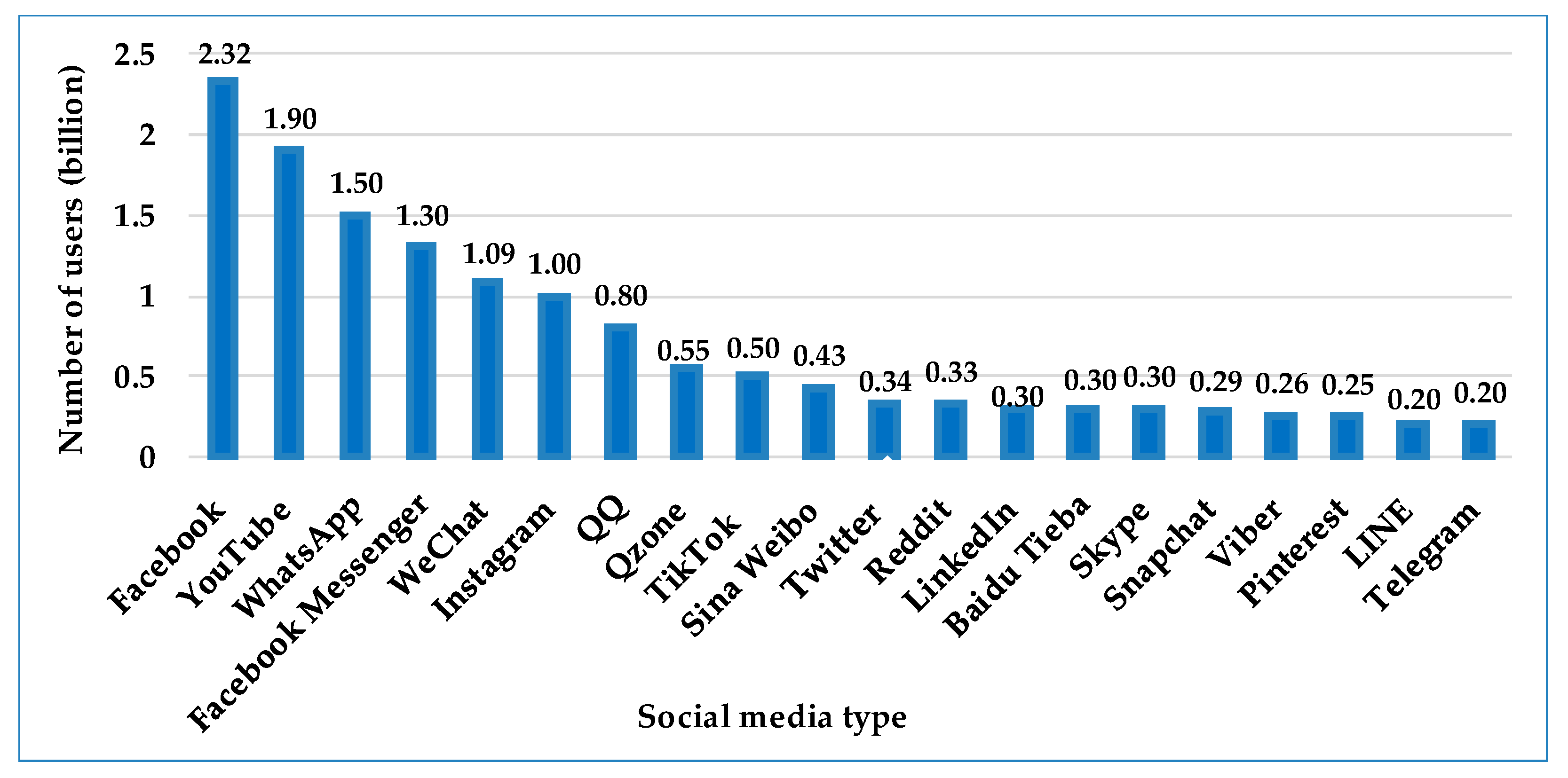
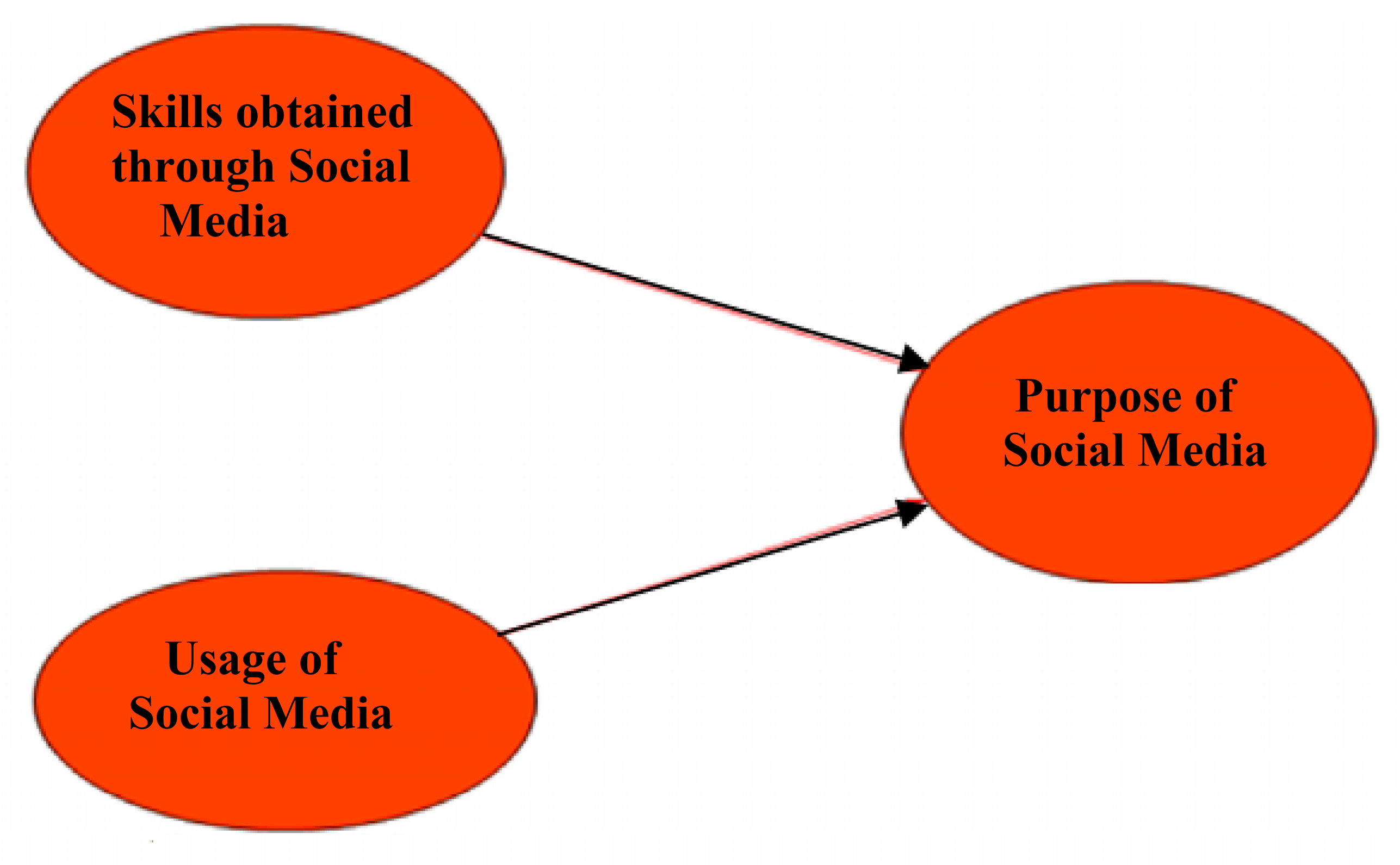
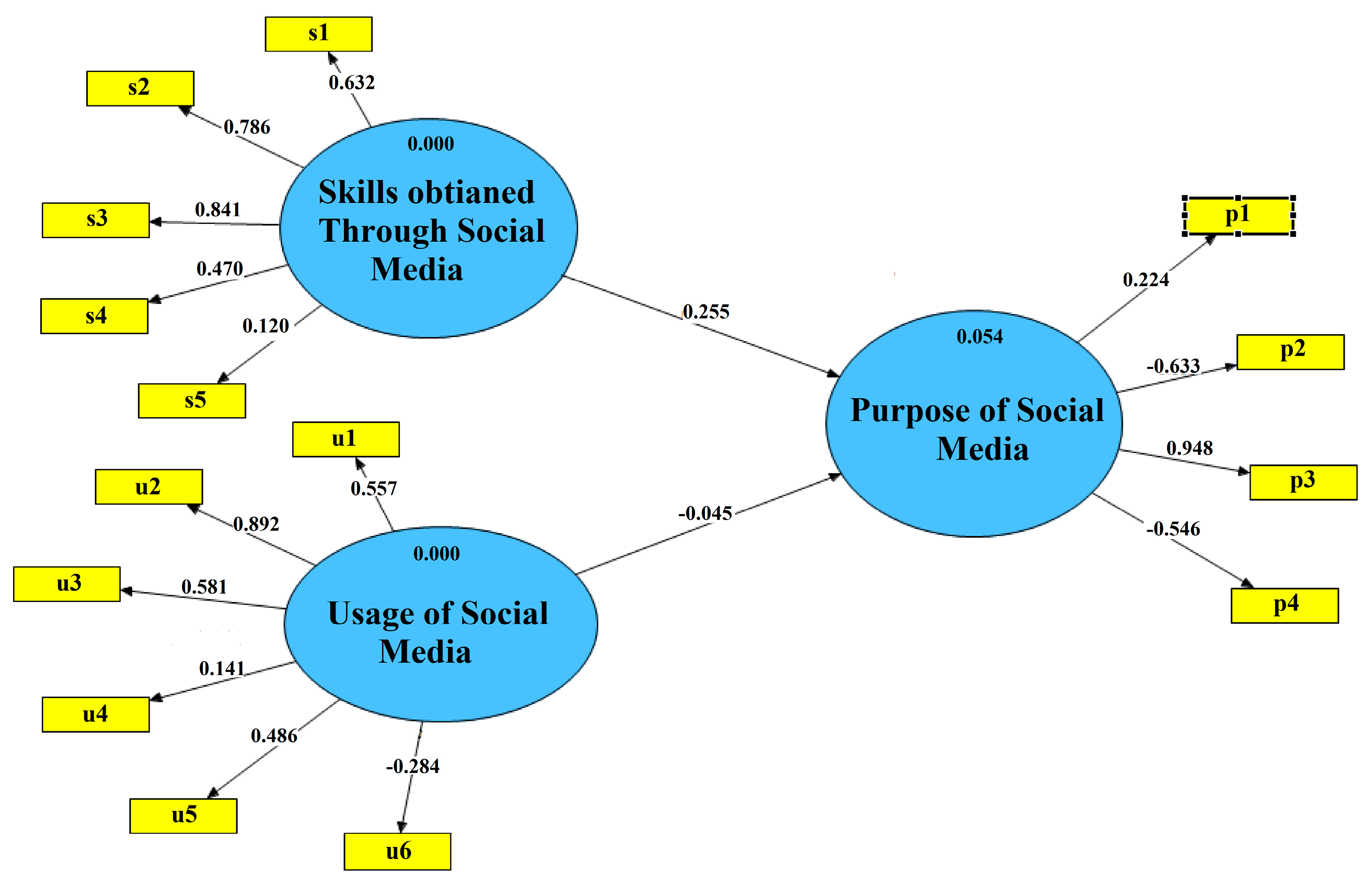
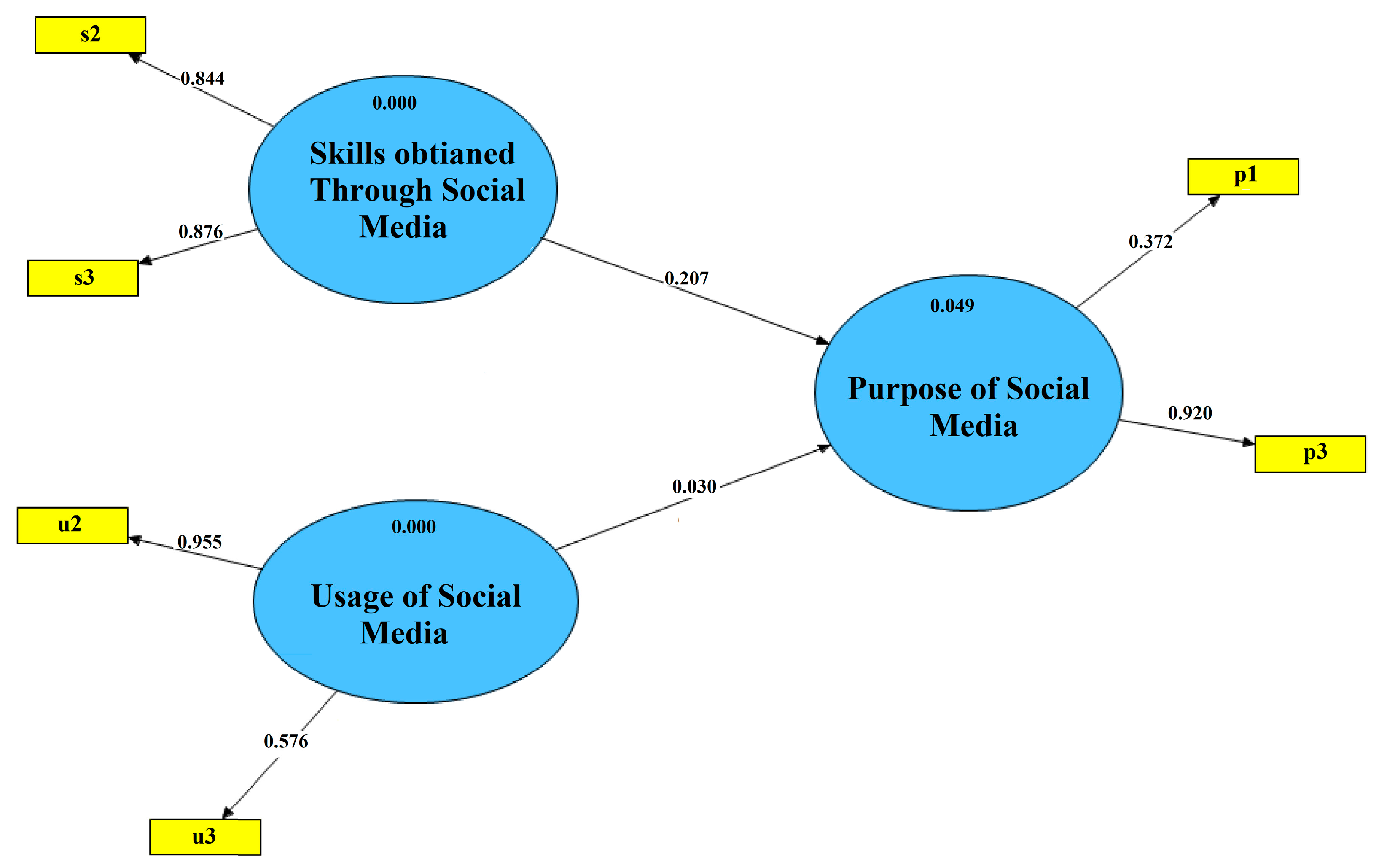
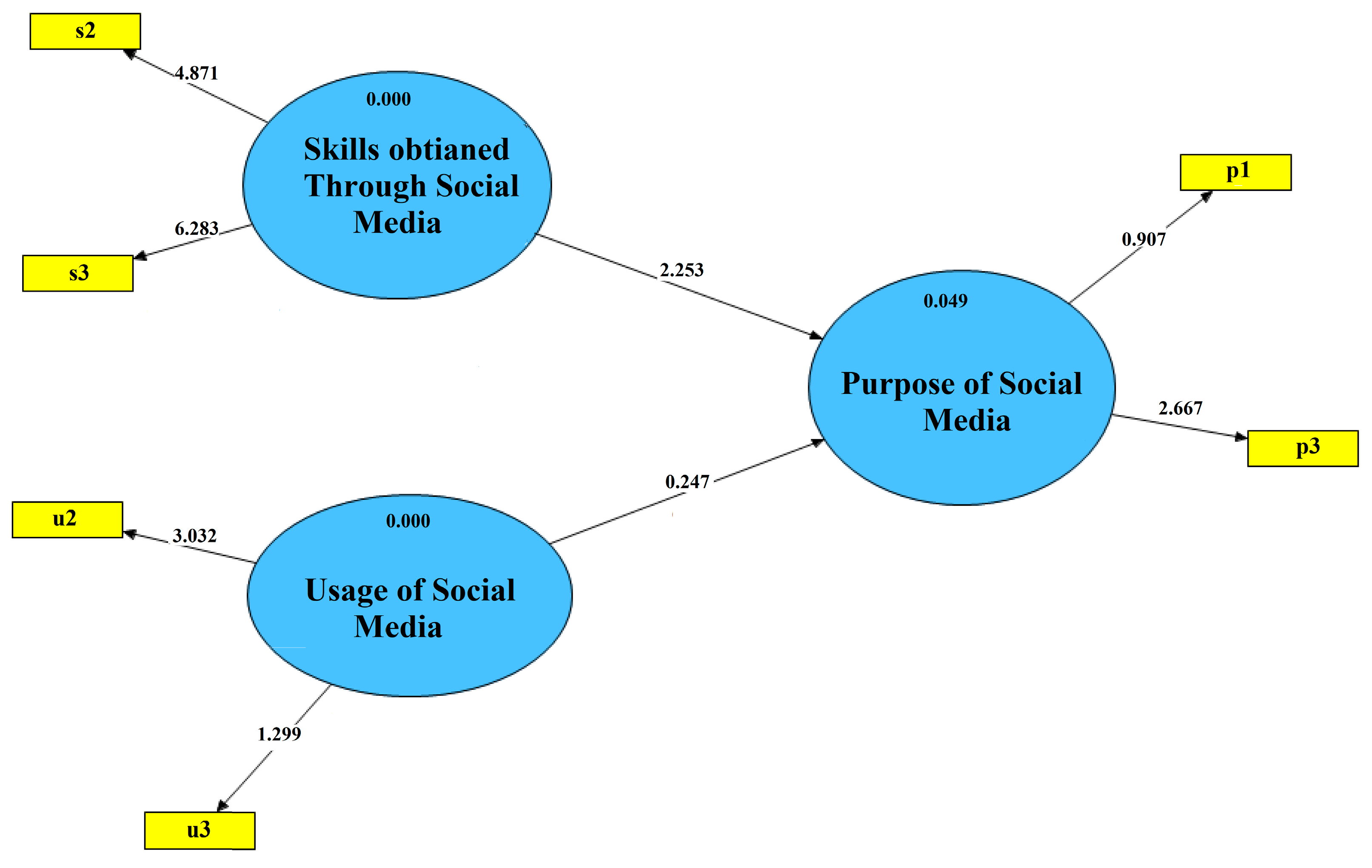

| Reference/Year | Type of Social Media | Method | Findings | |||||||||||
|---|---|---|---|---|---|---|---|---|---|---|---|---|---|---|
| 1 | 2 | 3 | 4 | 5 | 6 | 7 | 8 | 9 | 10 | 11 | 12 | 13 | ||
| Chytas, 2019 [10] | X | X | X | X | 84% supported using Facebook, and 86% supported using YouTube in the teaching environment | |||||||||
| Hashim, 2018 [11] | X | X | X | X | X | X | X | Comparison study of published papers over ten years (2008–2018); 85% of the publications were published as journal articles, 30% focused on social media in general, and 70% focused on specific applications, including 23% Twitter, 20% Facebook, 10% weblogs, 9% YouTube, 3% WhatsApp, and 40% adopted quantitative research; 10% of the research papers utilized a mixed-method | ||||||
| Al-Rahmi et al. 2018 [12] | X | X | X | X | X | X | 95% supported using social media for education and participation | |||||||
| Price et al. 2018 [13] | X | X | X | 81% supported using Twitter in teaching nursing courses | ||||||||||
| Bagarukayo, 2018 [14] | X | X | Questionnaire to explore using Facebook as a facilitated tool in teaching; 26.8% strongly agreed, and 44.4% agreed; however, 16.7% were neutral, and 12.1% did not agree or strongly disagreed. | |||||||||||
| Alhaddad, 2018 [15] | X | X | X | X | X | X | X | 90% supported using social media networking in medical studies | ||||||
| Duke et al. 2017 [16] | X | X | X | 96% supported using social media to discuss academic problems | ||||||||||
| Bal Erkan, 2017 [17] | X | X | X | X | 83% mentioned that using social media was an effective learning tool | |||||||||
| Tang, 2017 [18] | X | X | Examined 51 research papers and showed positive attitudes related to using Twitter in education; 56.8% used Twitter for subject-related materials, 33.3% used Twitter for formative assessment activities, and 90% of research work was implemented in the higher education field | |||||||||||
| Rueda, 2017 [19] | X | X | X | X | X | X | 156 students participated in the questionnaire; 90% of students regularly attended the classes, a strong relationship between student performance and satisfaction rate in information system courses using social media | |||||||
| Ali, 2017 [20] | X | X | X | X | X | 62% agreed, 23% disagreed, and 15% were not sure that social media positively improved the performance of students | ||||||||
| Benetoli, 2015 [21] | X | X | X | X | Twenty-four studies were included in this study based on inclusion criteria; the results showed that 78.5% of studies used specific social media tools in teaching pharmacy courses, and 58.3% of studies implemented social media sites, such as Twitter, Wiki, and blogs | |||||||||
| Kitching, 2015 [22] | X | X | X | X | Twelve staff participated in this study (in the healthcare sector from 11 organizations); most participants were cautioned about using social media in education | |||||||||
| Van Rooyen, 2015 [23] | X | X | 94% supported using social media technologies; 93.63% indicated that using social media made teaching more accessible and enjoyable | |||||||||||
| Eger, 2015 [24] | X | X | 77% used Facebook to improve their knowledge; 9% stated that they had not joined any study group on social media | |||||||||||
| Dunn, 2013 [25] | X | X | X | X | X | 68% believed that social media could improve the learning activity, 22% of participants disagreed, 10% of them were unsure; the experimental group results showed that 75% indicated using social media networks was very helpful, and 18% admitted it was helpful; however, 7% specified it as slightly helpful | ||||||||
| Junco, 2011 [26] | X | X | 48.20% indicated that Twitter could enhance academic development. | |||||||||||
| Moran, 2011 [27] | X | X | X | X | X | X | 40% of faculty members asked students to use social media networks to read and solve assignments | |||||||
| George, 2011 [28] | X | X | X | X | X | Students rated the quality of teaching through social media as 4.8 out of 5; the rate of using social media as electronic resources in medical schools was 4.7 out of 5 | ||||||||
| Wang, 2011 [32] | X | X | X | X | X | X | 20% of students used social media to solve their assignments, which contributed to their achievements | |||||||
| Characteristics | Frequency | Percent % | |
|---|---|---|---|
| Gender | No. of males | 24 | 12.0 |
| No. of females | 176 | 88.0 | |
| Age | 16 to <20 years old | 85 | 42.5 |
| 20 to <30 years old | 114 | 57.0 | |
| 30 years and above | 1 | 0.5 | |
| Educational qualification | Primary | 4 | 2.0 |
| Secondary | 1 | 0.5 | |
| Undergraduate | 195 | 97.5 | |
| Daily usage of social media | 1 to <3 h | 30 | 15.0 |
| 3 to <5 h | 47 | 23.5 | |
| 5 to <7 h | 62 | 31.0 | |
| 7 h and above | 61 | 30.5 |
| Factors (Latent Variables) | Subfactors (Apparent Variables) | |
|---|---|---|
| Skills obtained through social media | s1 | Social media helps students improve their communication skills |
| s2 | Using social media, students’ scientific level increases | |
| s3 | Social media develops students’ creative thinking | |
| s4 | Social media develops meaningful dialog and discussion skills | |
| s5 | Social media affects the students’ social skills | |
| Usage of social media | u1 | I use social media for educational purposes |
| u2 | Social media offers diversified educational experiences | |
| u3 | Social media offers lectures outside of study time | |
| u4 | Social media maintains the confidentiality of user information | |
| u5 | The use of social media has become a necessity because it shortens the effort and time | |
| Purpose of social media | p1 | I use social media for entertainment purpose |
| p2 | I use social media for study purposes | |
| p3 | I used social media mainly for social communications | |
| p4 | I use social media for trade and labor |
| Factors and Subfactors | Factor Loading | Cronbach’s Alpha | Composite Reliability | AVE | |
|---|---|---|---|---|---|
| P | Purpose of Social Media | 0.437012 | 0.621947 | 0.492445 | |
| p1 | I use social media for entertainment purpose | 0.372376 | |||
| p3 | I used social media mainly for social communication | 0.919905 | |||
| S | Skills obtained through Social Media | 0.649058 | 0.850378 | 0.739767 | |
| s3 | Social media develops students’ creative thinking | 0.844226 | |||
| s4 | Social media develops meaningful dialog and discussion skills | 0.87568 | |||
| U | Usage of Social Media | 0.472086 | 0.756344 | 0.622276 | |
| u3 | Social media offers lectures outside of study time | 0.955464 | |||
| u4 | Social media maintains the confidentiality of user information | 0.575882 |
| Purpose of Social Media | Skills Obtained through Social Media | Usage of SOCIAL Media | |
|---|---|---|---|
| Purpose of social media | 1 | ||
| Skills obtained through social media | 0.219999 | 1 | |
| Usage of social media | 0.119495 | 0.433187 | 1 |
| Factors | Original Sample (O) | Sample Mean (M) | Standard Deviation (STDEV) | Standard Error (STERR) | T Statistics (|O/STERR|) | Supported | Significance Values |
|---|---|---|---|---|---|---|---|
| Skills obtained through social media > purpose of social media | 0.207098 | 0.203789 | 0.09044 | 0.09044 | 2.289899 | Yes | p < 0.05 1.96 |
| Usage of social media > purpose of social media | 0.029783 | 0.081326 | 0.119063 | 0.119063 | 0.250144 | No | --- |
| Factors | R2 | Communality | H2 | Redundancy | F2 |
|---|---|---|---|---|---|
| Purpose of social media | 0.04912 | 0.492445 | −0.01 | 0.023786 | −0.122 |
| Skills obtained through social media | 0.739767 | 0.229 | 0.229 | ||
| Usage of social media | 0.622277 | −0.022 | −0.022 | ||
| Average | 0.04912 | 0.618163 | 0.017 | 0.454 | 0.316 |
| GOF = square-root (average R2 × average communality) = √0.04912 × 0.618163 = 0.174253, H2 is CV-communality index and F2 is CV-redundancy index | |||||
Publisher’s Note: MDPI stays neutral with regard to jurisdictional claims in published maps and institutional affiliations. |
© 2021 by the authors. Licensee MDPI, Basel, Switzerland. This article is an open access article distributed under the terms and conditions of the Creative Commons Attribution (CC BY) license (https://creativecommons.org/licenses/by/4.0/).
Share and Cite
Yousif, J.H.; Khan, F.R.; Al Jaradi, S.N.; Alshibli, A.S. Exploring the Influence of Social Media Usage for Academic Purposes Using a Partial Least Squares Approach. Computation 2021, 9, 64. https://0-doi-org.brum.beds.ac.uk/10.3390/computation9060064
Yousif JH, Khan FR, Al Jaradi SN, Alshibli AS. Exploring the Influence of Social Media Usage for Academic Purposes Using a Partial Least Squares Approach. Computation. 2021; 9(6):64. https://0-doi-org.brum.beds.ac.uk/10.3390/computation9060064
Chicago/Turabian StyleYousif, Jabar H., Firdouse R. Khan, Safiya N. Al Jaradi, and Aysha S. Alshibli. 2021. "Exploring the Influence of Social Media Usage for Academic Purposes Using a Partial Least Squares Approach" Computation 9, no. 6: 64. https://0-doi-org.brum.beds.ac.uk/10.3390/computation9060064







